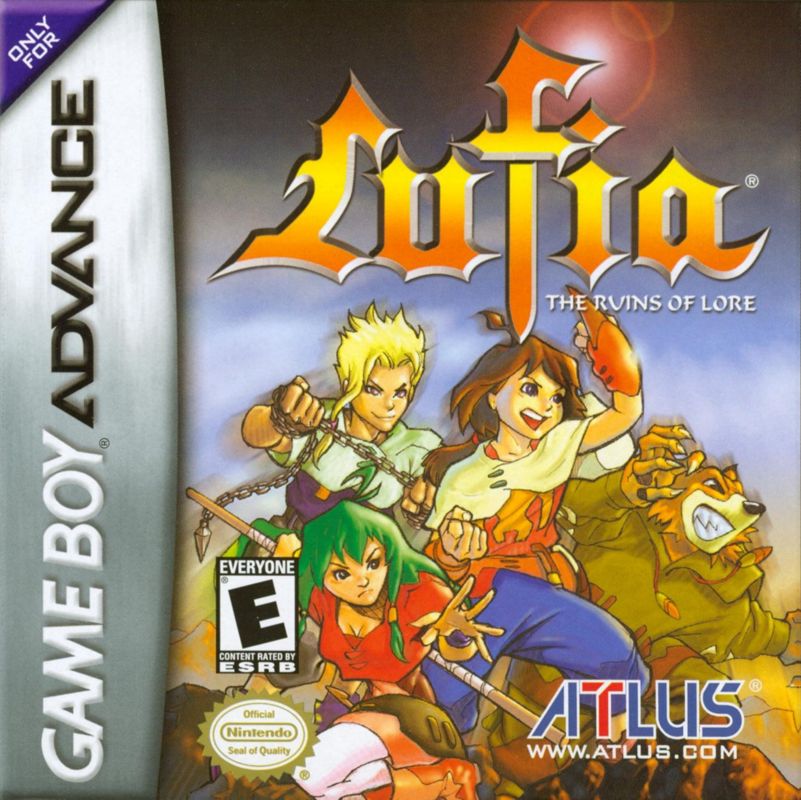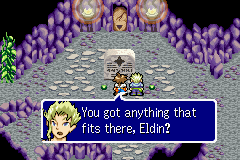Retro Replay Review
Gameplay
Lufia: The Ruins of Lore delivers a traditional JRPG experience with a modern twist, blending classic turn-based combat and visible enemy encounters. Instead of random battles, foes roam the overworld and dungeons, allowing you to choose when—and how—to engage. Approaching an enemy from behind grants you the first strike, adding a tactical layer to exploration and reward for careful navigation.
(HEY YOU!! We hope you enjoy! We try not to run ads. So basically, this is a very expensive hobby running this site. Please consider joining us for updates, forums, and more. Network w/ us to make some cash or friends while retro gaming, and you can win some free retro games for posting. Okay, carry on 👍)
The job system offers impressive flexibility. Characters can learn and switch between multiple classes, mastering skills and abilities unique to each profession. Whether you want Eldin to wield swords as a Knight or cast spells as a Mage, you can tailor your party to suit your play style. Hybrid builds are encouraged, and experimenting with skill combinations becomes a compelling reason to respec and replay tougher sections.
Monster capturing and fusion further enrich the gameplay loop. Special items allow you to trap enemies, turning them into persistent allies that level up alongside your heroes. You can even merge captured monsters with your party members, creating powerful hybrid forms. This strategic depth ensures that battles never feel stale, as you juggle human abilities with monster talents to overcome increasingly challenging bosses and encounters.
Exploration is rewarding, with hidden chests and secret paths in every ruin and town. Puzzles range from simple switch mechanisms to multi-step challenges that require both wit and party synergy. Side quests pepper the world map, often tied to your monster collection or job mastery, providing additional hours of content and giving players reasons to backtrack or explore earlier areas with new abilities.
Graphics
On the Game Boy Color hardware, Lufia: The Ruins of Lore showcases vibrant pixel art and detailed character sprites. Each setting—from sun-dappled forests to shadowy temple interiors—features a distinct color palette that enhances the mood. The transition from bright overworld maps to brooding dungeons is handled smoothly, immersing players in the game’s shifting atmospheres.
Character portraits during dialogue and battle sequences are expressive and well-animated. Eldin’s confident grin, Rami’s determined glare, and Torma’s steadfast loyalty shine through in each frame. Monster designs range from adorable slimes to fearsome dragons, striking a balance between charm and menace that keeps encounters visually engaging.
Spell and skill animations are surprisingly elaborate for a handheld RPG. Fireballs swirl into place, healing springs bubble around allies, and elemental effects crackle across the screen. These visual flourishes not only make each combat turn exciting but also provide clear feedback on what’s happening during hectic boss fights.
Menus and user interface elements are clean and intuitive, making class changes, item management, and monster fusion straightforward. Icons are distinct and easy to read, minimizing downtime spent navigating submenus. Overall, the graphical presentation is polished, taking full advantage of the platform’s capabilities without sacrificing performance.
Story
Set twenty-five years prior to the events of Fortress of Doom, Lufia: The Ruins of Lore explores the untold adventures of Eldin, a young treasure hunter driven by the mysterious disappearance of his father. Joined by his steadfast friends Torma and Rami, Eldin embarks on a quest to uncover ancient secrets hidden within long-forgotten ruins.
The narrative unfolds at a steady pace, balancing lighthearted character moments with darker twists. Early scenes depict the trio’s camaraderie as they crack jokes and share dreams of legendary treasures. As the plot deepens, the sinister ambitions of the kingdom of Gratze emerge, keen on reviving an ancient beast to conquer neighboring lands.
Fascinating lore pieces litter the world through journals, inscriptions, and NPC conversations. Discovering the history of bygone civilizations and the origins of the mysterious relics you seek adds layers of intrigue. Side stories involving captured monsters and job masters flesh out the world further, offering tantalizing glimpses into the lives of secondary characters.
Character development is one of the game’s strongest suits. Eldin must wrestle with his father’s legacy, Torma grapples with loyalty versus ambition, and Rami’s hidden past surfaces in emotionally charged cutscenes. These arcs converge seamlessly in the late game, leading to confrontations that tie character growth directly to the climax against Gratze’s forces.
Overall Experience
Lufia: The Ruins of Lore strikes a satisfying balance between classic RPG elements and fresh mechanics. The visible battle system and job flexibility make every play session feel dynamic, while monster capturing and fusion offer long-term goals that keep you invested. Combat remains challenging without ever feeling unfair, and the strategic depth encourages creative party builds.
The game’s pacing and world design guide you from one dungeon to the next smoothly, with just enough breathing room to explore towns, take on side quests, and tinker with your classes. Music and sound effects complement the visuals perfectly, from triumphant overworld themes to eerie dungeon tracks that heighten suspense.
For fans of traditional Japanese RPGs, Ruins of Lore delivers a memorable adventure bursting with charm, challenge, and narrative depth. Its prequel status enriches the larger Lufia franchise, providing backstory and world-building that longtime fans will appreciate, while newcomers can enjoy a self-contained tale of heroism and discovery.
Ultimately, The Ruins of Lore stands out on the Game Boy Color library as a robust, feature-packed RPG that refuses to feel dated. Whether you’re drawn by its story, enamored by its pixel art, or hooked on its battle systems, Eldin’s journey through ancient ruins promises an adventure well worth undertaking.
 Retro Replay Retro Replay gaming reviews, news, emulation, geek stuff and more!
Retro Replay Retro Replay gaming reviews, news, emulation, geek stuff and more!









Reviews
There are no reviews yet.